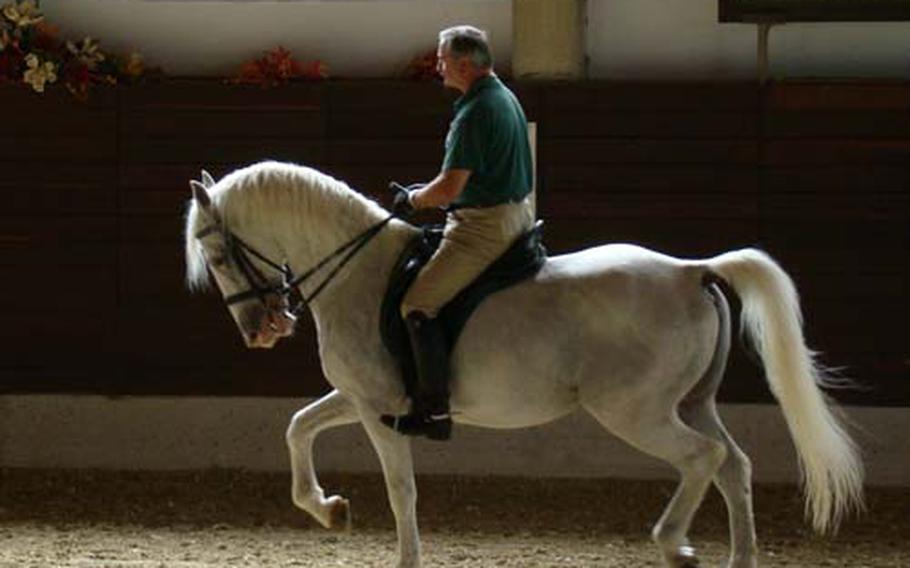Travel
Lipica: Breeding farm for the famous Lipizzaner stallions also serves as a resort
Stars and Stripes August 27, 2009

The fanciful riding style known as dressage is the specialty of Lipizzaner stallions. (Jim Sajo/Special to Stars and Stripes)
“The noblest conquest man has ever made is the horse.”
— Georges Louis Leclerc, French naturalist, mathematician and philosopher
Despite its elegant tree-lined entryway, 400-year history and royal connection, the farm just across the Italian border in western Slovenia is no stodgy or elitist hideaway.
Rather, it is the world’s oldest facility breeding the famed Lipizzaner horses. And if you believe an American family living in Verona, Italy, it is also “one very fun place to visit.”
In the late 1500s, the Hapsburg family of Austria ruled an empire that covered much of what we know today as Europe. The royal family sent military forces, tax collectors and diplomats across their lands to ensure orderly rule. All that travel meant horses — strong, well-disciplined, even-tempered horses.
Few breeds possess those characteristics more than the Lipizzan. Today, we know them for their magnificent white coat and the stylized dancing gait they display in shows around the world. But the Hapsburg emperor, Ferdinand I, valued them for their endurance and strength.
Not wanting to leave the health of his equine fleet to chance, the emperor charged his son, Charles II, with establishing a breeding farm. Charles chose an abandoned estate near the small village of Lipica, Slovenia. It was the first stud farm established to breed the sturdy white horse, and is still operating today.
The Lipizzan is smaller than most other breeds, generally just a little taller than 15 hands (hands are the accepted measure of horses, one hand being equivalent to four inches). But they possess remarkable endurance, an ideal trait for the long carriage trips the Hapsburg government required of them. They also live longer, on average 10 years longer than other breeds.
The horses are best known for their striking white coat (they are albino, but only the hair color is affected — no vision problems), fantastically strong neck and long mane. At birth, foals are dark, sometimes black, but the coat changes color when the animal is between 4 and 12 years old.
Today, beyond breeding and training activities, the Lipica stud farm doubles as a resort and recreation area for the whole family. Two hotels, a golf course, tennis courts, a swimming pool and a casino complement the farm. Guided tours or independent visits of the breeding facilities, where 40 or 50 Lipizzans are born annually, are available.
There are lessons for beginner through expert riders. Visitors can emulate the royal family of Austria by taking a carriage ride around the sweeping grounds of the estate, and young children can enjoy pony rides.
Guests can also watch training sessions throughout the day, where horse and rider work together on the artistic marching style known as dressage. Alternatively, three times each week a formal presentation of classical riding-school dressage thrills up to 800 visitors in the indoor arena.
It takes a rider/trainer an average of six to seven years working with a horse before the pair is ready for performances. Typically, riders begin their own training as children, often following their parents, who were trainers themselves.
Today, the herd at Lipica is more than 400. This includes 68 elite stallions in training. Only males are used in shows and demonstrations; females breed, care for the young, pull carriages and entertain human visitors.
Last year, more than 150,000 visitors passed through the gate to watch the horses and riders, the most famous being Queen Elizabeth II. Not famous, but just as enchanted by the farm, American Tom Piasecki called it “one of the best places I have ever taken my kids.”
The Lipica farm has passed from control of the Austrian Empire to Italy, then the former Yugoslavia. Today the government of Slovenia runs it. Not every transition has been smooth, however.
In 1797, the herd of more than 300 horses had to be moved to Hungary, out of danger from French forces led by Napoleon. During World War II, German troops claimed the horses as war trophies and moved them to present-day Slovakia. After the war U.S. Gen. George S. Patton, a horse lover and Olympic rider, mounted Operation Cowboy to rescue the herd from the Germans, protect it from the advancing Soviet army and return it to Lipica.
Jim Sajo is a freelance writer living in northern Italy. Visit his web site at www.jimsajo.com.